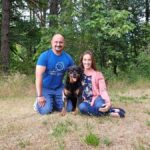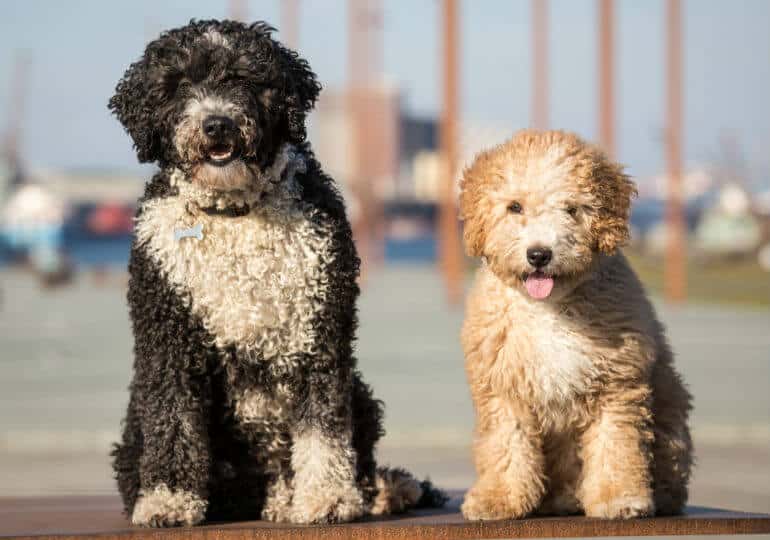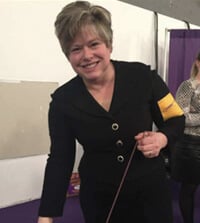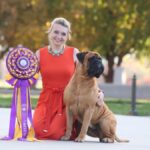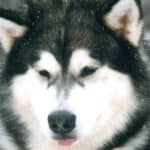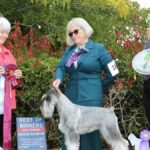Interview with Herding Group Breeder Lisa Harper
Where do I live? How many years in dogs? How many years as a breeder?
Lisa Harper: I live in central Connecticut; third generation on the family farm. My family, originally from the Eastern Shore, had Chesapeake Bay Dogs in the 1920s, and my teenage great-uncle had the honor of owning and showing the great Gypsy Bob who appears in almost every Chesapeake pedigree today. I broke from family tradition (gasp!) and started my own AKC journey with Portuguese Water Dogs under the eye of Judy Seibert at Piedelai kennel in the early 1990s. Judy gave me my first Spanish Water Dog (SWD) in 2000. Since then, I founded the breed’s parent clubs (UKC and AKC), served on the Boards for 21 years, chaired Health and Wellness, served at Judges Education Coordinator, and am currently serving my second term on the Standard Committee. The rest, as they say, is history!
What is my kennel name? How many dogs do I currently keep?
Lisa Harper: As I was a classically-trained singer in a previous life, my kennel name is Ariosa. My husband, Raimo Tuomela, is a Finnish breeder of SWDs. We merged our packs a few years ago and currently live with five SWDs in a wide range of ages. I also co-own a handful of outstanding dogs. I primarily breed for my own purposes. My dogs are housedogs. We average only 1-2 litters per year. During the first two years of the pandemic, we chose not to breed at all because owners were not able to get their pups to puppy classes. I do so love raising puppies right, and this year we have two litters planned.
Which show dogs from the past have been my noteworthy winners?
Lisa Harper: Spanish Water Dogs are still in their infancy with the AKC. My “Tia” (CH Bruma de Benamaina) and “Oso” (CH Euro de la Petaca) were the first SWDs registered with the AKC through the FSS program. My heart dog was one of their get, “Pink” (BISS CH Beloved Pretty In Pink de Ariosa) who garnered the first AKC Agility title and the first PT Herding title by luck of the draw—our good friend finished her SWD’s PT just minutes after Pinkie. I’m fortunate to have a “sister in dogs,” Colleen Nolan, with whom I co-own dogs. Our co-owned dogs, under Colleen’s tutelage, are trailblazers in our breed in several venues, including Obedience, Rally, Dock Diving, FastCAT, and Scentwork… they have too many titles to list in this space. I had the honor to show our beautiful co-owned “Kai” (BISS BISOH GCHS Angel Kiss the S’Kai de Ariosa CD BN RE CAA FCAT2 CGCA, suffix titles under Colleen), downline from Pink, who won BOBs at our National Specialty and Westminster. My current show girl, “Phoebe,” out of Kai and fellow Westminster winner “Hudson” (CH Zorrazo Xplorer) is probably the best I’ve bred in 22 years in the breed! I’m truly excited to see where she goes.
Which have been my most influential sires and dams?
Lisa Harper: This is a hard one. I definitely have a type to which I aspire. Our breed has a very small North American gene pool, so I often look outside of the country or to excellent dogs that may not be represented in order to preserve and expand our gene pool.
Can I talk a bit about my facilities? Where are my puppies whelped? How are they raised?
Lisa Harper: Of course! I’m a very serious hobby breeder, averaging one litter per year and breeding primarily for my own purposes. The dogs are born in the home and raised in the living room. I have a hoot of a time bringing them up. I cut my work hours back to part-time while puppies are on the ground so that the pups can get as much attention and socialization as possible.
What is my “process” for selecting show puppies? At what age do I make my decisions?
Lisa Harper: I’m not looking for a top show prospect. I’m looking for the total dog; beautiful, happy, healthy, typey working dogs. Pairings are very carefully matched and almost always include reaching out to sires in other parts of the world. The pups, of course, get early neurological stimulation. Although behaviorists say that testing temperament is a bunch of bunk, I find it so very helpful. I was fortunate to have lived down the street from Pat Hastings and I use her methods to evaluate conformation at 8 weeks. Sometimes I’ll also reach out to a chiropractor for further evaluations. And, of course, I do some DNA tests on the pups before they leave the litter and take those into account.
How do I prepare my pups for the show ring? Does my breed require any special preparation?
Lisa Harper: I enjoy showing puppies while waiting for them to grow up enough to do other sports, then bringing them back to the ring as mature adults. As the breed does not enjoy being reached for or leaned over, I generally start them off in handling class on a table. I enjoy showing, and I want my pups to have a great time, too. When I lived in Oregon, we really enjoyed the IABCA shows because the pups could play a bit in the ring, resulting in super ring attitude.
As adults, we have the option of showing our dogs in 1-5 inches of rustic coat. I used to show my dogs in full cords, but honestly, I love the way our breed looks in 2″ of coat: so sporty and powerful. Although the breed is rustic and is NEVER to be brushed or aesthetically trimmed, achieving a beautiful coat of curls or cords has a large learning curve. I enjoy helping folks and have seen a huge improvement in presentation over the years.
Are Performance and Companion titles important to me as a breeder? Are parent club titles?
Lisa Harper: Yes, yes, yes! Anything that demonstrates the partnership between dog and owner impresses me. That said, will I use a dog that has no titles to his name? It depends on what he brings to the table in pedigree, breed type, movement, health, and character.
In my opinion, is my breed in good condition overall? Any trends that warrant concern?
Lisa Harper: We have a tiny gene pool here in the US and Canada, so a handful of stellar studs have, in my opinion, been overused (not that I am not guilty of partaking with select matches). There is a huge gene pool open to us in Spain and other parts of Europe. The Spanish stud book is still open, so folks importing from Spain will need to be sure dogs have full 3-generation pedigrees in order to be registered with the AKC.
Our parent clubs around the world closely attend to health issues and developing DNA tests for our concerns. Overall, the breed is very healthy, with the biggest concerns being prcd-PRA and hypothyroidism at the same general rate as most breeds. Other genetic diseases are present but are not common. Conformationally, we are working through a period of cowhocks and mastering the 9:8 body ratio, but already I see folks are improving those areas.
Is my breed well-suited to be a family dog? Who are the best candidates to own my breed?
Lisa Harper: This breed is superb with families and children, providing the family applies firm and fair household rules. Our biggest problem with this breed is that they are medium-sized, hypoallergenic, and very cute. Folks forget they have a herding dog temperament: socially alert, bonded to their people, wary of strangers, and in need of a job. The breed thrives with a great deal of socialization throughout their lives. They can be a bit guard-y. Families that routinely have non-residents entering their homes unannounced (neighbors coming over to use the pool, cleaning ladies, etc.) may have some issues. But if you’re looking for a devoted family dog eager to participate in all you do, if you’re an active sort or enjoy any sport, this multi-purpose breed may be for you. Herding, hunting, water sports, ski-joring, agility, conformation, obedience and rally, nosework, barn hunt, search and rescue… this breed stands out!
Do I feel that my breed is supported by a sufficient number of preservation breeders?
Lisa Harper: Not quite yet. We are a young community, and most folks are still learning about the breed. We will get there. Also, because our breed landed in the Herding Group in the US, the Gun Dog group in the UK, and is a water dog in the FCI, some folks forget this is a rustic, multi-purpose breed. Our standard, and the standards around the world, are clear: the three main functions are herding, hunting, and assistants to fisherman.
For a bit of fun, what’s the most amusing thing I’ve ever experienced with a Herding Dog?
Lisa Harper: Well, this isn’t herding (which we used to do when I was young and a bit fitter), but as an all-around farm dog, this breed was expected to keep the vermin population down. We have quite a chipmunk population on our farm and surrounding woods, and some of the dogs are obsessed with hunting chippies. Sometimes, they’d dig a hole so deep into a chippie tunnel that all you could see was a madly wagging nubbin and dirt flying. But the funniest thing Pink and Ave would do was to trap a chippie inside a 10 ft. piece of plastic drainage tile. Then, one would take the tube by one end and shake it madly until the chippie flew out the other end, whereupon the second dog would dispatch it.
Anything else I would like to share about myself? Any special message I have for all of us in the fancy?
Lisa Harper: Be kind. Continue learning about your breed, even if you consider yourself an expert. Mentor and be mentored. Help others succeed. Breed to the dog, not to the owner. Enjoy life.
